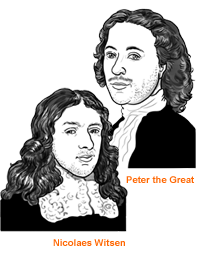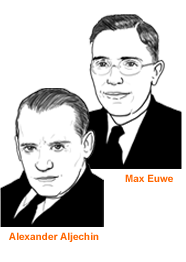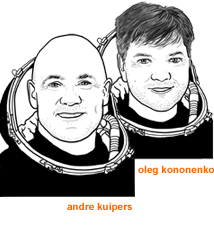Russia & the Netherlands
Three famous encounters i
When great minds meet, it can lead to great things. For example, Dutch-Russian trade relations kicked off with a meeting between Peter the Great and Nicolaes Witsen who both were not averse to playing the political game. Another memorable Russo-Dutch meeting of minds took place in the 1930s with the mental contest between the talented chess players Max Euwe and Alexander Alekhine; a showdown between two completely different personalities in a time of great contrast. These days relations between the two countries are on a more equal footing, as can be seen in the most recent Russo-Dutch meeting of minds between astronaut André Kuipers and cosmonaut Oleg Kononenko; two men with a dream who worked together closely and with mutual respect at the International Space Station. .
Origin of the Russian flag
'When the Holy Prophecy ship anchored at Archangel, the great red-white-blue banner of Holland floated from her stern. Peter, admiring the ship and everything about her, immediately decided that his own naval flag should be modeled after it. Accordingly, he took the Dutch design -- threes broad horizontal stripes, red on top, white in the middle and blue on the bottom -- and simple changed the sequence. In the Russian flag, white was on top, then blue, then red. This naval flag quickly became the flag of the Russian empire and remained so until the fall of the dynasty in 1917.' (From the book 'Peter the Great' by Robert K. Massie)
Peter the Great & Nicolaes Witsen

So far this is all standard Dutch history book material, however whatis less known is the role played by the mayor of Amsterdam, Nicolaes Witsen. It was he who arranged for Peter to work on the frigate Petrus en Paulus in Amsterdam, which earned Witsen a further good reputation with the tsar. In addition to his administrative duties, he was a scientist who wrote a standard work on shipping. Witsen was also a cartographer, and it was he who had produced the first serious map of Siberia in 1687. He was able to do so partly thanks to his cousin Andries Winius, an interpreter at the Russian court and a confidant of Peter the Great - although the tsar was unaware of the link between Andries and Nicolaes.
The meeting between Peter the Great and Nicolaes Witsen in Amsterdam sparked a close commercial relationship between the two countries. Witsen was to become the tsar's leading 'agent' in the Netherlands, in exchange for which he was issued with 'ukases ' for the conduct of trade with the Russians. To this day ukase – derived from the Russian word for an imperial edict – remains a familiar term in the Netherlands. Conversely, Peter's visit to the Netherlands led to the introduction of Dutch shipping and other terms into the Russian language, including the words for cabin, sideburns and jack.
Tsar Peter House, Zaandam
The Tsar Peter House is one of the oldest wooden houses in the Netherlands and is where Peter the Great stayed in the summer of 1697. A brick construction has been built around the monument to protect it from the elements. The house, which recently underwent restoration work with the support of sponsor Summa Group, can be visited as part of the Zaans Museum. In combination with the nearby windmills of Zaanse Schans the museum gives a good picture of the Low Countries' past. www.zaansmuseum.nl
Alexander Alekhine & Max Euwe

In 1933 reigning world champion Alekhine challenged Euwe to a match for the title. Initially Euwe had his doubts. As a teacher at a girls' school he considered he was unable to free up enough time for chess. However, in 1935 he accepted the challenge. His preparations were very thorough, not just mentally but also physically: Euwe took up boxing and took a cold shower every morning. At first it looked as if this was all going to be to no avail as odds-on favourite Alekhine took a 6-3 lead. But after 30 games in 13 Dutch cities and villages – which raised the funding for the match – the tables turned. Euwe won an unexpected 15½-14½ victory and became world champion, the only amateur player ever to achieve this. The victory was a huge boost for the crisis-struck Netherlands and chess clubs saw their membership treble.
Euwe was not able to enjoy his title for long though: two years later he lost again to Alekhine in a revenge match in which he was outclassed (9½-15½). Euwe paid his starting money into a fund for the promotion of chess and carried on working hard. He later became the first Dutch professor of Information Science and president of the World Chess Federation, FIDE.
Max Euwe Museum, Amsterdam
Following Max Euwe's death the Max Euwe Centre was established. This foundation's objective was to keep alive the Dutch world champion's work and significance to the game of chess and to promote the sport. Photographs, documents and memorabilia are on display in a small museum in the centre of Amsterdam. The centre also traces the history of the game from its earliest origins in India and the Arab world to the present day. www.maxeuwe.nl
André Kuipers & Oleg Kononenko

In his book Droomvlucht he describes how this became his second home. He writes of his relationship with the Russians: "At first they come across as a little gruff, but they are in fact very friendly and easy to get along with. What you see is what you get – same as with the Dutch." In the same book Kuipers also talks about his space mission of 193 days, the longest ever by a European astronaut. He explains how the Russian language and traditions are reflected in the ISS, for example describing the picture of cosmonaut Yuri Gagarin and rocket engineer Sergei Korolev in the service module. And he talks about the 'kajoetas' (derived from the Dutch word 'kajuit') – the two sleeping cabins for Russian cosmonauts. However, his favourite spot was not a kajoeta but the Cupola, where he could observe Planet Earth in all its glory.
In addition to his scientific work Kuipers attached another objective to his trip. He wanted to promote space travel, for example through the pictures he sent out via social media. Kuipers believes that space travel not only brings nations closer together, but also builds awareness of the importance of treating the planet responsibly. "Ideally everyone should have this experience. It is only in space that you really realise that we live in a vulnerable oasis in an inhospitable universe."
Space Expo, Noordwijk
Space Expo is the official visitors' centre of ESTEC, the Dutch arm of the European Space Agency (ESA). The museum features interactive displays to introduce visitors to space and space travel. Space Expo is home to the permanent exhibition Spaceship Earth about André Kuipers and the ISS. A tourist train is now also running to take visitors to the Information centre for the International Space Station (on the ESA site).
www.spaceexpo.nl